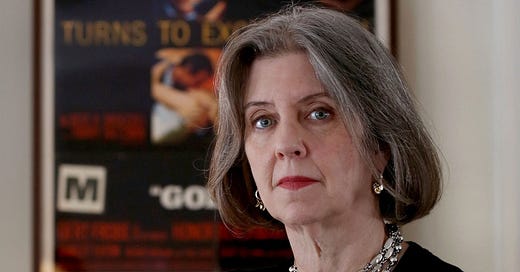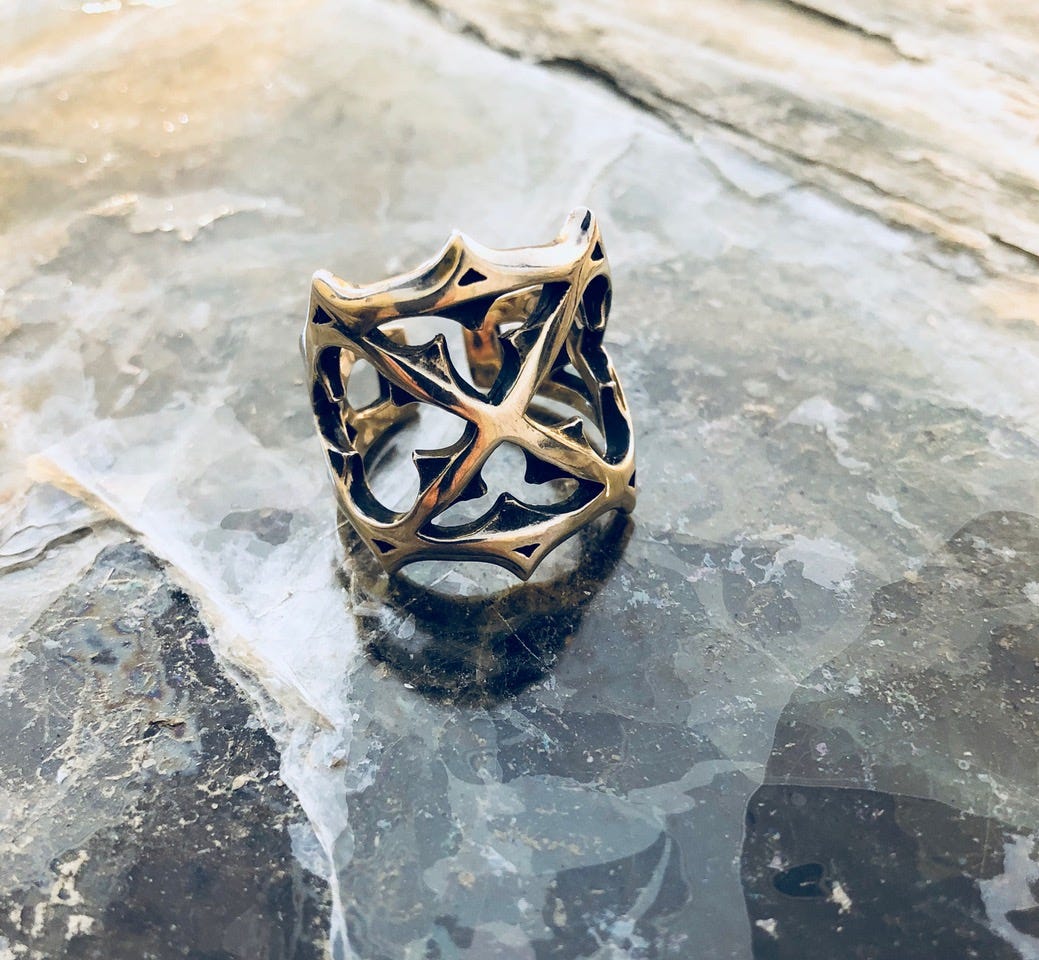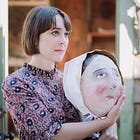CR 038: Dana Schneider on Bringing Bling to the Big Screen
The acclaimed jewelry designer discusses her extraordinary career, from “The Matrix Reloaded” to “The Hunger Games” and beyond.
In the 1980s, Dana Schneider was making a successful living as a jewelry designer, selling her pieces in stores around the country. But a few years into her career, she realized it might be time for a change. “I started not being satisfied with selling wholesale jewelry to boutiques and stores,” she says. “I was doing well at it. Getting a name. But I felt really confined by trends. Stores would say, ‘This is selling. Can you give us something new, but not too different?’ It was really restricting and boring. I was making all this crazy, wild, heavy metal jewelry, and I knew that I didn’t have an outlet for it.”
Despite having no connections to the entertainment industry, Schneider decided to move to Los Angeles and pursue work in film and television. Within two years, she was designing jewelry for The Matrix Reloaded and The Matrix Revolutions. Today she has more than 80 high-profile credits to her name. Her jewelry has been seen in The Hunger Games, Top Gun: Maverick, The Girl with the Dragon Tattoo, Fast & Furious, Game of Thrones, Californication, and many, many others. (This summer, her pieces will be worn by Rachel Brosnahan’s Lois Lane in the highly anticipated Superman.) In addition to her film and TV work, she operates a high-end Etsy store, where she sells pieces like the Gothic Cross Ring, a favorite of Cher’s that was originally listed for sale in the singer’s Sanctuary catalog.
Although Schneider says she’s grateful for her success, she points out that it hasn’t come easily. “It's been really hard work,” she says. “I sometimes work seven days a week. I miss a lot of social events. I turn down things. I’ve gotten really protective of my time. I really question, ‘Is going to this wine tasting going to make me feel better than finishing a piece?’ Probably not. There has been a lot of sacrifice because I’m committed to what I do, whether it’s for myself or a movie. Without that, I never could have done what I have.”
From her home in Ohio, Schneider spoke with me over Zoom about her early days of designing, her love for heavy metal music, and creating the iconic Hunger Games mockingjay pin.
SANDRA EBEJER: I understand you went to the Rhode Island School of Design. How did you first get into designing jewelry?
DANA SCHNEIDER: Well, at RISD, I studied sculpture, and was mainly, in the last three years, working in the foundry on steel, cast aluminum, and bronze. My first job out of RISD was Tiffany’s in New York on Fifth Avenue. I knew enough about how jewelry was made and after a while being at Tiffany’s, I thought, the way young people do, “If they can make jewelry and sell it, so can I.” [Laughs] So, I quit Tiffany’s, which maybe wasn't a great idea, but that’s what I did. I actually tried to get my welding license in New York City. I went to the school there and went through all their stupid tests. I finally talked to someone, and he’s like, “What are you doing here? You don’t belong here. Go away.” In part because I was female, but I also had a college degree. So that left me with making small things in my loft.
I got a flexible shaft machine, which enabled me to start carving wood and plexiglass, and that’s what I started making jewelry with. I tried going to craft shows, like the Smithsonian Craft Show and Philadelphia Museum of Art Craft Show, thinking maybe that was the place I should be selling. It wasn’t. My jewelry was a little too fashion-forward to fit into the craft world. But there was a great gallery in Soho called ARTWEAR that Robert Lee Morris ran. I showed them my jewelry, and they’re like, “We’ll take you on. This is great!”
So I was selling to stores throughout the country and getting good press from magazines. Then I thought I should start expanding from plexiglass and exotic woods into metal. With my same flexible shaft machine, I ordered some different tools and [taught] myself how to carve wax models, to do lost wax casting into silver. I was pretty clueless, but I thought, “I can figure this out.” And eventually I did. I was back in the metal genre that I felt comfortable in at RISD. I like metal, metallics, sparkly things, so that’s how I got into designing my own lines with a wider range of styles. Learning how to carve wax models was really liberating. All of a sudden, I could do anything. I wasn’t confined by my materials anymore.
I read an interview with you in which you talked about moving to L.A. and basically restarting your life, all in pursuit of working in film and television. What drove your desire to design jewelry for the entertainment industry?
I had actually wanted to for a long time, because I was always looking at jewelry in movies and TV. Early on in doing the silver work, teaching myself how to do things, I would imagine, “If I were making the jewelry for this movie, what would I do?” So I was already doing this on my own as inspiration.
One day, I saw the trailer for the first Matrix, and was like, “This is amazing!” I knew immediately there were going to be sequels. I thought, “Even if I’m just making cufflinks for the sequel, that would be great.” Three months later, I moved to LA. I knew someone I could rent a guest house from, but that was it. I knew no one. No idea how to break in. So again, I jump in, thinking, “I’ll figure it out.” Eventually I did, but it was really hard. I thought many times, “This was really stupid. What was I thinking?” But I stuck it out. And once I did start having meetings with costume designers, it just took off. I had a huge portfolio of jewelry to show them in person, so they could see I had skills.
Many of the projects you’ve worked on have elements of science fiction or fantasy. At this stage of your career, what types of projects are you drawn to the most?
I love science fiction, action-adventure, special effects, and things exploding. But when I’m looking at what’s going into production, I look into who a director is, who’s their cast. The cast is going to tell me whether or not it’s something I'll want to work on, because there are some actors you know are really only going to do serious drama, in which case the costume designer will probably just go shopping. They don’t need custom stuff, or don't have the time or the budget. So I like the really big, eye-catching ones that are blockbusters. Who doesn’t want to work on that?
What is the process like when you’re working on a film or TV show? Do they come to you with specific ideas? Do you design something based on the script?
All of that. And every movie is different. Every costume designer approaches things differently. Usually it starts with me showing them lots of jewelry. I’m always trying to come up with new things, because if they’ve seen it before, they don’t need to see it again. So I’m always developing new things. Sometimes they’ll just buy my designs right there and order multiples. Sometimes they’ll say, “We like this, but can you do this sort of design on it instead?” You know, like a cuff bracelet. “We want flowers instead of Celtic.” I love doing that. I love gearing things towards the character, the story. I like being able to see what the costume designer is being inspired by—what fabrics, colors, looks. It’s a process that I really enjoy. Some costume designers let me in more. They tell me more about the project. I’ve worked on things, though, where they won’t even tell me the name. I can almost always figure it out, but it’s like they’re not allowed to utter the name, and confidentiality contracts are ever-present now.
Have you ever had a significant challenge, like a piece that you were trying to design just wasn’t gelling, or perhaps yours wasn't the same vision as the filmmaker? How do you navigate those challenges?
You have to have really good communication. People think you can do everything over Zoom. You can’t with jewelry. It’s about weight, scale, size. You need to have it in your hand in order to really tell whether or not it’s right. Sometimes I’ll send wax models if I’m not wherever they are, like Atlanta or Toronto or something, which will help. But they’re usually so rough that the costume designer can’t get a great idea of the finished product. So it’s a lot of communication. I used to do a lot of all-nighters just to meet deadlines. Sometimes I had really short deadlines, or sometimes, as you say, maybe I went left instead of right on a design and had to start over. But that’s where the communication [comes in] of really understanding the character, the story. Are there a lot of action scenes where you have to have stunt doubles? There are a lot of things to consider with it.
Does an action scene change how you design a piece?
Yeah. Like with earrings—normally, I like to use what’s called a French wire, a hook I hand-make myself. But there are also earring parts that are called lever backs that literally have a little lever in the back, and these are more secure on ears in action scenes. So then you’re thinking, “The earring's going to hang a little lower then.” There are little minutia things like that that you have to think about. With rings, they have to be able to make stunt doubles out of rubber, latex, or whatever, so you don’t want anything sharp and jagged where they could hurt themselves. So again, there are a lot of detailed questions that need to be answered when you’re doing this. Now I know to ask them. [Laughs] Once I made a belt buckle for a movie for a really pretty young woman, and she wanted a skull and a horseshoe with some rhinestones. I made a scary skull on a horseshoe, and she’s like, “What are you doing?” That's where I didn’t ask the right questions. But you learn, and now I’m better at that.
The mockingjay pin is probably your most iconic piece of jewelry. How did that come about?
I had worked with the costume designer and her assistant before, so they knew my work. Probably my second most recognizable [piece] is what I call the Sun Bird pendant. They had seen that, they’d seen my other work, and that’s what gave them confidence to ask me. And that was a detailed process, also. To take a vague 2D image and turn it into a functioning pin is not easy, to put it mildly. How are you going to hold the arrow in the beak? Where’s the pin back going to go? How thick is it going to be? It’s got to be light, so it works on costumes. That probably took two, three months to work out all the details on.
Is that a normal time frame? How long does it typically take for you to create a piece of jewelry if you’re designing it from scratch?
I’m usually one of the last people they call, and unfortunately, they know I’ll come through, so they keep doing it to me. I’m lucky sometimes if I have two weeks, from carving a model, having it cast into silver—I cast all my prototypes in silver. Then it’s got to be sent back to me for finishing, then sent back for molding so they can make multiples for me to ship to them. I had one project, though, [with] belt buckles. There was no time for the extra molding for multiples. I had to carve four identical buckles, which, again, all-nighters, but it was a great movie I was doing a lot of work on. I’m like, “I am gonna do this!” [Laughs]
Are you typically designing a piece for a specific character? Or are you designing multiple pieces to be worn by multiple characters? Or both?
All of it. I can go in to see a costume designer—maybe they’re just looking for something for the lead actress, but then they’ll see my men’s jewelry and say, “Oh, wait, we could put this on so and so.” And that’s, again, why the face-to-face meetings are really important. It’s hard to tell from pictures, whether or not [it will work]. Holding it in your hand is really crucial.
You’re probably one of the only major Hollywood designers who also has a shop on Etsy. How often do you create just for the pure joy of it?
Actually, almost all of it I make just for me, whether or not there’s an audience out there. Maybe I carved an owl yesterday and tomorrow I want to carve a seashell or something. I just go with what I feel like making that day. I’ll set out in the morning to do one thing and end up doing something completely different later in the day. When I try to make designs for Etsy, it doesn’t work well. I’m just not good at understanding what the average buyer wants. Some people have a knack. I don’t, probably because I’m not an average buyer of jewelry, and so I don’t think that way. But Etsy functions really well. It protects the buyer and the seller. They take care of all the taxes and shipping. But yeah, I’m probably one of the highest end jewelers on Etsy, which is a difficulty. And having people find me on Etsy is hard. But when I start working on a movie, I can just shut it down, whereas if I’m selling through stores, they don’t like that. As soon as I started working on a lot of movies, I stopped doing wholesale jewelry because I just couldn’t do both. Etsy gives me that freedom to shut down for a few months.
When you look back at your career, what are some of the projects or designs or moments that stand out?
Definitely working on The Matrix 2 and 3 was a dream come true. Two years after I dreamt [about] working on the sequels, I was. I got to go on sets and meet all the actors. I knew I was in heaven, and I savored the moments to remember. So that was big. Certainly the mockingjay. I knew the [Hunger Game] books had been bought to be produced. And so as soon as the costume designer said, “Well, there's this bird pin,” I knew what it was gonna be. That was pretty exciting. Also, seven seasons of Californication was pretty wild. Getting to know that costume designer all those years—I still work with her and have a really good relationship with her. Whatever she’s working on, I want to do it. And that’s part of what I enjoy—it’s work, but it’s also friendships that you develop.
Who are some of your influences? Are there any artists you turn to for inspiration?
People don’t think I like this, but I’m a real heavy metal fan. In my 30s, I discovered heavy metal and so all I do is listen to new stuff. I don’t listen to anything more than maybe 15 years old. So I get a lot of inspiration from what, primarily, the men are wearing. But what I also love about metal is it gives me a sense of strength, a feeling that you can overcome. You can get up off your feet again. You’ll survive this. You have it in you. It’s very empowering for me. I don’t know if anyone else gets that, but it puts a smile on my face. And when I feel powerful, strong, then the designs just come. I have to feel that strength in myself for it to be successful.
To learn more about Dana Schneider, visit her website.
This interview has been edited for clarity and length.
You might also enjoy…












Terrific interview! That is quite a career! Thanks for including the photos of her work.